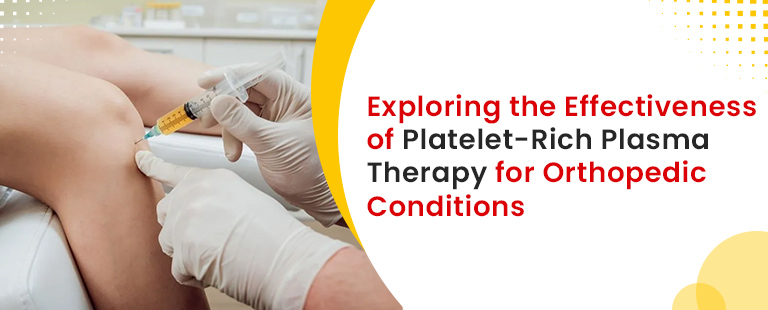Introduction
For an individual having arthritis, even simple daily tasks can be difficult to perform. This happens because the inflammatory joint disease leads to joint pain, stiffness, and a decrease in mobility, and the condition can worsen with time.
Traditionally, there are a few treatment options that can help in relieving the arthritis symptoms. But with an advance in medicine, a regenerative form of medicine, known as platelet-rich plasma or PRP therapy has emerged as a popular treatment option for arthritis.
Unlike the use of medicines that can only help in masking the pain or reducing inflammation in arthritis cases, regenerative treatment methods like PRP help in activating the healing process in the body. PRP therapy helps in relieving the symptoms associated with arthritis by restoring the healthy cells and tissue at the site of treatment.
In this article, we will be discussing why you should consider PRP therapy to treat your arthritis.
What is PRP?
Platelet-rich plasma or PRP is produced from an individual’s own blood. It consists of a concentration rich in platelets and growth factors.
Platelets are a type of blood cells that play an important role in the healing and regeneration of tissues. The platelets release certain growth factors that send some signals to the cells, triggering the process of healing.
Platelets and growth factors help in relieving pain, and inflammation, and also slow down the progress of arthritis.
How Does PRP Therapy Help Arthritis Patients?
PRP therapy is a promising form of treatment that helps in treating arthritis patients in several ways. PRP can help arthritis patients in the following ways:
- Reduces joint inflammation
- Reduces joint pain
- Helps in cartilage regeneration
- Improves the function and movement of joints
- Delays or prevents the risk of developing arthritis
Preparation for PRP Therapy
Your doctor will guide you on the necessary steps you need to take before undergoing PRP therapy for improved treatment experience and results. The general guidelines before undergoing PRP therapy are as follows:
- Avoid taking blood thinners like aspirin and ibuprofen for a few days before the procedure.
- Inform the doctor if you have any medical conditions that may affect your blood condition, like anemia, cancer, or abnormal platelet count.
- Have a proper meal before the procedure to avoid lightheadedness when blood is drawn from your body for the procedure.
How is PRP Therapy Performed for Arthritis Patients?
PRP therapy is commonly used for treating arthritis of the knee, shoulder, elbow, and hip joints, but it can also be used to treat other types of joints including the joints in the spine region.
PRP therapy is provided to arthritis patients in the following way:
- A small amount of the patient’s blood is first drawn by a medical professional.
- The blood sample will then be placed into a machine known as a centrifuge. The machine will then be spun around at a high speed to allow the separation of blood into different components, including the platelet-rich plasma or PRP component.
- The PRP is then prepared for injection.
- The doctor will then use imaging guidance, such as an ultrasound or fluoroscopy, to precisely guide the PRP injection to the desired body area.
The whole PRP injection process takes approximately one hour to complete. Most people can resume their daily activities following PRP therapy. It may take many weeks before noticing a difference in the treatment area.
Recovery After PRP Therapy
After receiving a PRP injection for arthritis treatment, the doctor may recommend the following to ensure a quick and smooth recovery:
- Apply an ice pack for twenty minutes every two to three hours on the site of the PRP injection for the first two days following treatment. It is common to notice some swelling and redness on the injection site after the procedure.
- Avoid strenuous activities that may cause stress in the treatment area.
- Avoid taking NSAIDs (non-steroidal anti-inflammatory drugs) after the treatment as it could block the effect of PRP therapy.
- Ask your doctor when you can resume vigorous forms of physical exercise like cycling or running.
Benefits of PRP Therapy
PRP therapy offers several advantages in arthritis cases. The various benefits of PRP therapy include the following:
- Safe and effective procedure
- Autologous and natural procedure, which means that the PRP is obtained from the patient’s own body
- Stimulates the body’s own healing process
- Restoration of hyaluronic acid in the arthritic joints, which is a substance that helps in lubricating and cushioning the joint and is usually reduced in arthritis cases
Risks of PRP Therapy
PRP therapy is generally considered to be a safe procedure and there is no risk of any immune reaction or allergy to PRP treatment as the plasma is obtained from the patient’s own blood. Some minor side effects that could occur as a result of PRP therapy include the following:
- Pain at the site of injection
- Infection (low risk)
Conclusion
PRP therapy is a type of regenerative medicinal technique that helps activate the natural healing process in the body. The therapy helps arthritis patients by reducing joint pain and inflammation, improving joint function and mobility, regeneration of the cartilage, and delaying the progress of arthritis.
PRP therapy is a safe and effective arthritis treatment method with minimal or no risk of side effects. However, not all arthritis patients are good candidates for undergoing PRP therapy. You need to talk to your orthopedic surgeon to know if PRP therapy can work in treating arthritis symptoms in your case.



